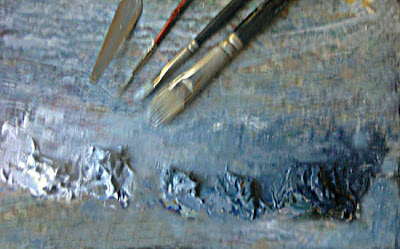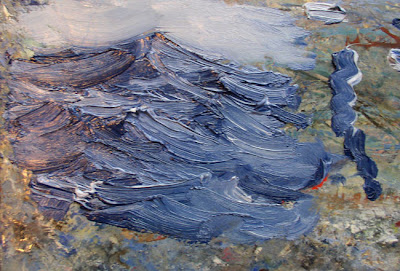 Above is a corner of my palette with five premixed values of a blue-gray tone. When I showed it last someone asked how it was mixed. I simply made a big pile of the darkest version using ultramarine, a little ivory black and a smidgen of titanium white. Each of the other piles was produced by diluting that "mother" color with gradually increasing amounts of white. I could of course do this with any "mother" color I wanted and sometimes I have several of these "strings" of color on my palette when I paint seascape, but seldom when painting anything else.
Above is a corner of my palette with five premixed values of a blue-gray tone. When I showed it last someone asked how it was mixed. I simply made a big pile of the darkest version using ultramarine, a little ivory black and a smidgen of titanium white. Each of the other piles was produced by diluting that "mother" color with gradually increasing amounts of white. I could of course do this with any "mother" color I wanted and sometimes I have several of these "strings" of color on my palette when I paint seascape, but seldom when painting anything else.Below is an example painted on my palette of the use of a double loaded brush. I dipped one side (corner) of my flat brush into a dark pile and the other side into a light pile. Now I have two different values (or if I want, two different colors) on my brush. Over on the right I pulled a stroke to show you the kind of mark such a double loaded brush will make. I then painted the little wave study using a double loaded brush. I reloaded the brush after every few stokes.
 I have worked at getting this effect to work for a long time and really only figured out how to do it reliably quite recently. It takes some practice and experimentation to control it. I found a reference to Frederick Waugh using this effect. The observer noted that Waugh twisted ( twirled) his brush between his fingers as he worked. That puts the dark on top sometimes and then the light note at others. It will also cause a striation of values within a plane of the water. If you look at the sketch above you can clearly see that. It is important to have the right white when doing this, Waugh used Permalba, but I painted this sketch using RGH (link in my sidebar) titanium white, the Lefranc is good too, and Winsor Newton is slippery, but stay out of the student gradee paints or anything too stiff or crumbly..The important thing for this is that the white is slippery and and somewhat soft, be sure you get the right ONE. Sometimes I add a little stand or linseed oil to get it to move better.
I have worked at getting this effect to work for a long time and really only figured out how to do it reliably quite recently. It takes some practice and experimentation to control it. I found a reference to Frederick Waugh using this effect. The observer noted that Waugh twisted ( twirled) his brush between his fingers as he worked. That puts the dark on top sometimes and then the light note at others. It will also cause a striation of values within a plane of the water. If you look at the sketch above you can clearly see that. It is important to have the right white when doing this, Waugh used Permalba, but I painted this sketch using RGH (link in my sidebar) titanium white, the Lefranc is good too, and Winsor Newton is slippery, but stay out of the student gradee paints or anything too stiff or crumbly..The important thing for this is that the white is slippery and and somewhat soft, be sure you get the right ONE. Sometimes I add a little stand or linseed oil to get it to move better.When I am doing this I am thinking about how the various planes of the water are facing. I also pull the shadow strokes downward and the lights up from below. There are all sorts of little niceties of handling, brush pressure and edge control that can be explored with a double loaded brush.




14 comments:
A video demo will be great, thanks for the tip!
Stape, that really does look like a small maelstrom on your palette; pretty cool. To be clear, when you refer to applying paint to the 'side' of your brush, do you mean you apply paint half and half on the same side (plane) of the flat brush, or on the front and then the reverse planes of the brush? Hope this makes sense...
Robert Sesco;
Perhaps I should have said "the corners of the brush. I didn't mean the front and back.
..................Stape
Have you been watching Donna Dewberry?
Simone:
I have no idea who Donna Dewberry is.I don't have a TV so I haven't been watching anyone. Her name sounds like someone I wouldn't like though. Donna Reed is OK, no others please.
..................Stape
Thanks for another great tip...You're an inspiration!
Stape, thank you for sharing this. That patch of water is so wonderful it gives me chills. I have so much to learn and you help me to do so. Thank you!
PS. I saw my first Sorrolla "in the paint" so to speak a couple of weeks ago. It gave me chills, too. Thank you for having turned me on to him.
By the way, I watched a video of you and 17 other painters on youtube. I must confess, you have a wide range of... appearances, ranging from Zappa as "Bear Claw" in 'Jeremiah Johnson' to your current George Clooney 'Ocean's Eleven' professional thief look. I'm sure this will drive future historians and auctioneers wild with delight. Your photos will be displayed next to one of your paintings on Antiques Roadshow in the next century, and someone will be advised to insure for a small fortune.
Yes, Stape, you absolutely would not like Donna Dewberry. She is a big name in arts and crafts. Famous for her instructional videos on one stroke painting where she loads the brush with multiple colors to paint a leaf or a flower. Most of her painting is done on kitchen walls, you know, faux painting. I know about her from the days when we had cable television. We still have the television but ditched the cable a while ago....
Really enjoyed this one, Stape; you've brought to light seascape techniques not often mentioned!
Thank you, thank you, thank you. Today I've made it back to the current post. I don't know how you kept up with the daily blog as long as you did. On the days there is nothing new, now, I can review with my morning coffee. I am ready to stop swimming on the sofa. I am inspired.
Please make a video of this. The waves are amazing and I would like to see the technique in action.
Terrific post Stape. I have a large Montague Dawson print in which a lot of the ocean looks like your pallette demo.
I was at Schoodic Point on Wednesday and tried your color and stroke suggestions, but, it seems, I will need to practice more.
Part of what works in your wave study is the underlying color mix from the palette itself, as it gives some added dimension to the wave form, yes?
Post a Comment